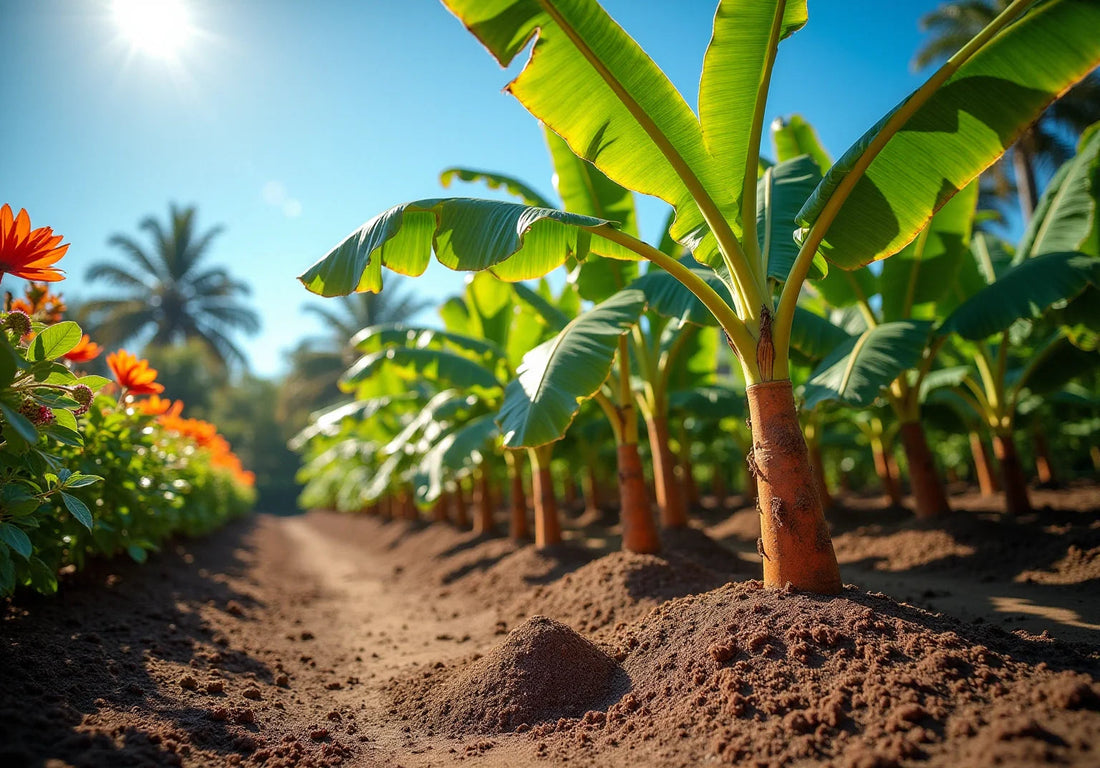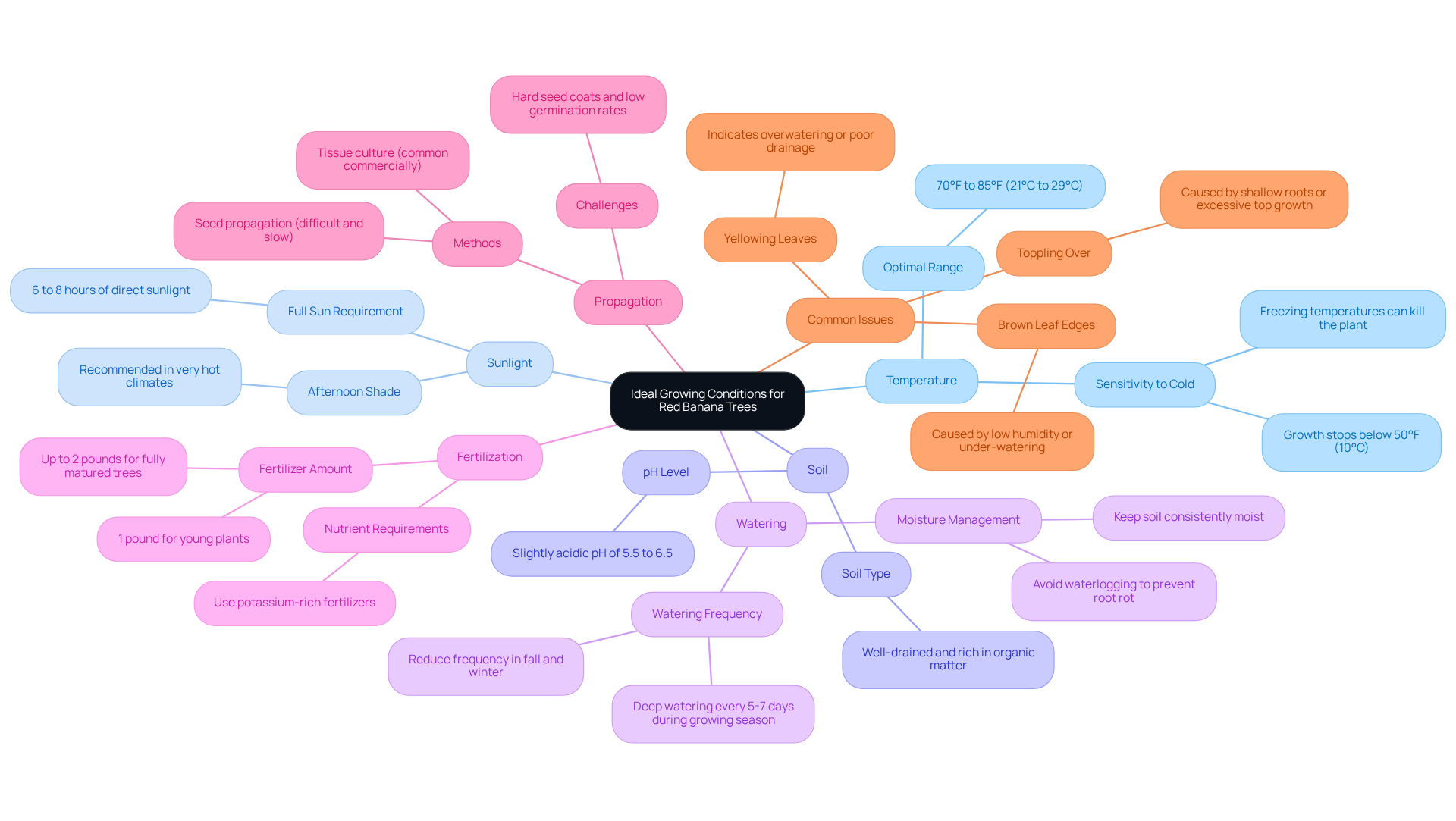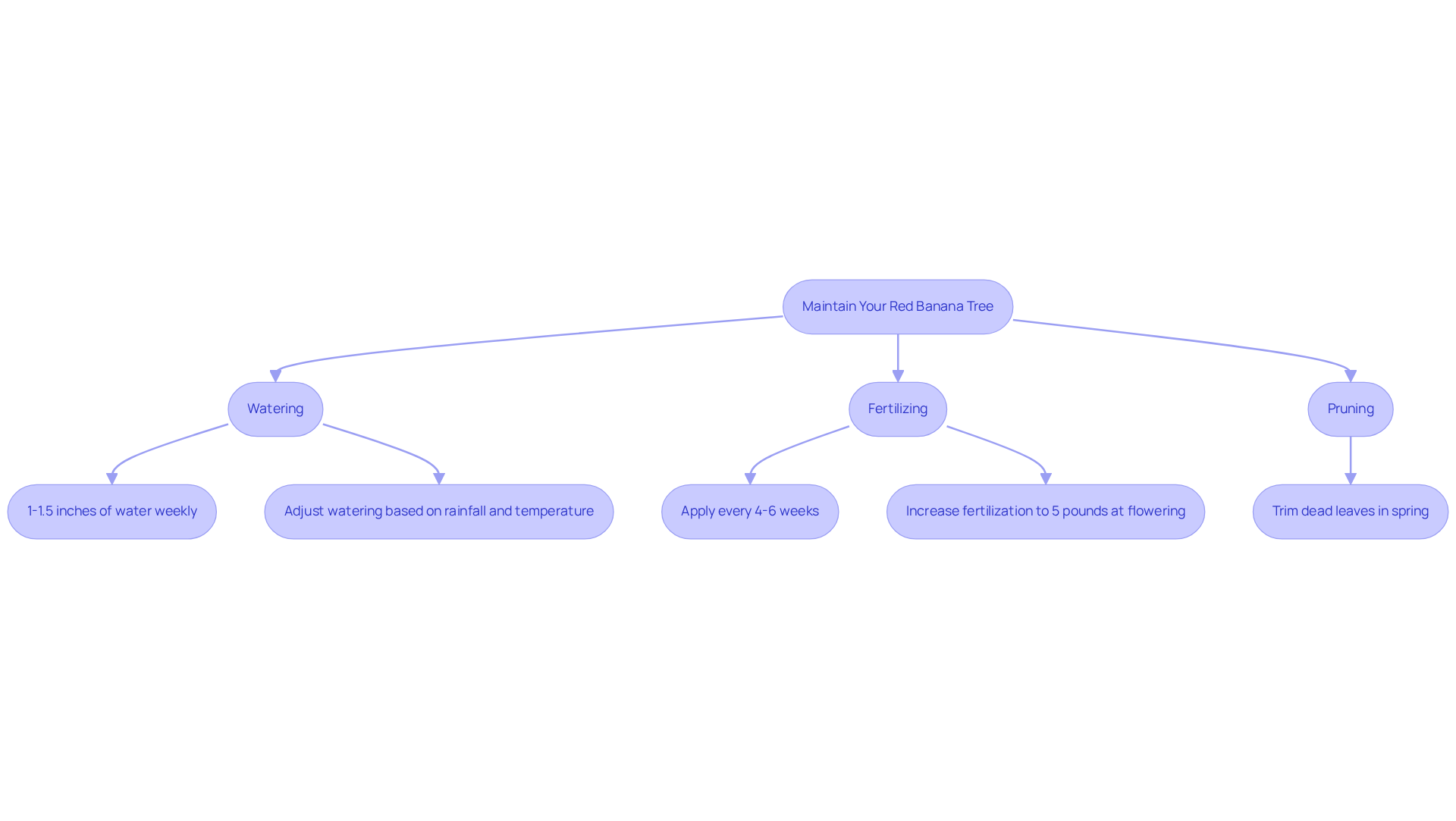
Do Red Banana Trees Produce Fruit? Essential Growing Steps
Share
Red banana trees do indeed produce fruit when cultivated under optimal conditions, which include ample sunlight, adequate watering, and nutrient-rich soil. This article outlines essential steps for growing and maintaining these tropical fruit trees.
- Regular fertilization with potassium-rich fertilizers is particularly crucial, as it promotes robust growth and enhances fruit production.
- By following these practices, gardeners can ensure a successful harvest and enjoy the unique flavors of red bananas.
Thinking about growing a banana tree in your garden?
Consider Red Banana Tree at Everglades Farm - shipped directly from Florida.
Red banana trees, recognized for their striking appearance and unique fruit, require specific conditions to thrive in home gardens. Understanding the ideal climate, soil requirements, and maintenance practices allows gardeners to unlock the potential of these vibrant plants.
However, an important question arises: do red banana trees actually produce fruit, and what steps must be taken to ensure a bountiful harvest? By exploring the intricacies of their growth and care, we not only appreciate the beauty of these tropical wonders but also confront the challenges associated with cultivating them.
1. Understand the Ideal Growing Conditions for Red Banana Trees
Red banana trees thrive in warm, tropical climates, with optimal temperatures ranging from 70°F to 85°F (21°C to 29°C). They flourish in full sun, requiring at least 6 to 8 hours of direct sunlight each day. The soil should be well-drained and rich in organic matter, ideally with a slightly acidic pH of 5.5 to 6.5.
Additionally, selecting a planting site that offers protection from strong winds is crucial, as the large leaves are susceptible to damage. Regular watering is essential to keep the soil consistently moist; however, care must be taken to avoid waterlogging, which can lead to root rot. To promote healthy development, utilizing Everglades Farm's is recommended. For young plants, start with 1 pound, increasing to as much as 2 pounds for fully matured specimens. These fertilizers provide essential nutrients that foster vigorous growth, leading one to wonder, do red banana trees produce fruit?
Red banana plants can be propagated by seed or tissue culture, though these techniques can be challenging. Common issues include brown leaf edges, often due to low humidity or under-watering, making it vital to maintain adequate moisture levels. When planting, ensure the site is sheltered from strong winds to protect the large leaves.
Red banana plants can reach heights of 6 to 15 feet and widths of 4 to 10 feet, necessitating careful planning of their spacing. For quick-yield tropical greenery, explore Everglades Farm's Fast-Growing Trees Collection, which can enhance your home gardening experience.

2. Plant Your Red Banana Tree: Step-by-Step Instructions
- Choose the Right Location: Select a sunny area with excellent drainage, avoiding spots prone to standing water. Banana trees flourish in warm temperatures, ideally around 80°F (27°C), and require at least 8 hours of sunlight daily for optimal growth.
- Prepare the Ground: Enhance the soil by mixing in organic matter such as compost, which boosts fertility and drainage. The optimal pH level for plantain crops ranges from 6.0 to 7.5, providing a favorable environment for development. Additionally, banana roots primarily occupy the upper 20 inches (50 cm) of soil, so ensure the ground is well-prepared within this depth.
- Dig the Hole: Create a hole that is twice the width and the same depth as the root ball of the plant. This allows ample space for the roots to expand and establish themselves effectively.
- Plant the Sapling: Position the sapling in the hole, ensuring that the top of the root ball is level with the ground surface. Backfill with soil and gently compact it to eliminate air pockets that can hinder root growth.
- Water Generously: After planting, water the tree deeply to help settle the soil around the roots. Maintain a steady level of moisture in the ground, avoiding saturation, as these tropical species require approximately 4-10 inches (100-250 mm) of water each month for robust growth.
As Ben Barkan, a garden and landscape designer, advises, "To cultivate these plants, plant a few suckers in a sunny location with ." By adhering to these guidelines, you will lay the foundation for a thriving banana plant, which raises the question: do red banana trees produce fruit?

3. Maintain Your Red Banana Tree: Watering, Fertilizing, and Pruning
To ensure the health and productivity of your red banana tree, it is essential to follow these maintenance practices:
- Watering: Regularly hydrate your red banana plant, aiming for approximately 1 to 1.5 inches of water each week. Adjust the frequency based on rainfall and temperature conditions, as consistent soil moisture is crucial for healthy growth.
- Fertilizing: During the growing season, apply a balanced, organic fertilizer every 4 to 6 weeks. Focus on fertilizers that are high in potassium, as this nutrient is vital for promoting robust growth and enhancing fruit production. Gradually increase fertilization to about five pounds as the plant approaches flowering and fruiting stages.
- Pruning: Trim your red banana plant by removing any dead or damaged leaves to encourage new growth. The optimal period for pruning is during the spring, preparing the plant for the active growing season. However, avoid excessive pruning, as this can stress the plant and hinder its development.
- Container Requirements: If cultivating in pots, ensure your red plant is in a large container that is at least 18 inches wide and deep, with good drainage. This will help support its growth and stability.
By following these practices, you can nurture a flourishing red plant and discover if red banana trees produce fruit, enhancing the beauty of your garden while yielding tasty fruit. Keep in mind that these tropical species usually require 9 to 12 months from sowing to gathering, so patience is essential!

4. Troubleshoot Common Problems with Red Banana Trees
- Yellowing Leaves: This condition often signals overwatering or nutrient deficiencies. To address this issue, examine the soil moisture levels and consider using a balanced fertilizer rich in potassium, which is essential for these crops. Conducting soil tests can help identify specific nutrient needs, preventing imbalances that may exacerbate the problem. Additionally, it is important to recognize that natural aging can cause older leaves to yellow as part of the organism's lifecycle.
- Brown Leaf Edges: Typically indicative of low humidity or underwatering, brown leaf edges can be remedied by increasing watering frequency. Misting the leaves can also help boost humidity levels, creating a more favorable environment for growth. Furthermore, low potassium levels can lead to yellowing at the margins and tips of plant leaves, making it crucial to ensure sufficient potassium is available.
- Pest Infestations: Be vigilant for common pests such as aphids and spider mites, which can harm banana vegetation. Treat infestations promptly with or neem oil. Regular examinations of the foliage will aid in identifying any pest problems swiftly, safeguarding the well-being of your greenery.
- Root Rot: Adequate drainage of the medium is critical to avoid root rot, which can occur due to excessive watering. If root rot is detected, remove the affected specimen and replant it in fresh, well-draining soil. Ensuring that your banana crops do not sit in waterlogged conditions will promote healthier root systems and overall vitality. Preventive measures, such as ensuring proper drainage and avoiding waterlogged conditions, are essential for maintaining plant health.
Conclusion
Red banana trees, characterized by their vibrant foliage and unique fruit, necessitate specific conditions and care for optimal growth. Successfully cultivating these tropical plants requires an understanding of their ideal growing environment, effective planting techniques, and ongoing maintenance practices. By adhering to the outlined steps and recommendations, gardeners can appreciate not only the aesthetic appeal of red banana trees but also the delicious fruit they yield.
Key aspects include the significance of:
- Warm temperatures
- Well-drained soil
- Consistent moisture levels
Employing effective techniques for:
- Watering
- Fertilizing
- Pruning
is essential for promoting healthy growth and fruiting. Furthermore, addressing common challenges such as:
- Yellowing leaves
- Pest infestations
- Root rot
is vital for ensuring that red banana trees remain robust and productive.
In conclusion, nurturing red banana trees is a rewarding endeavor that enhances any garden space. By implementing the best practices highlighted throughout this article, gardeners can anticipate a fruitful harvest while enjoying the striking beauty of these tropical plants. Embracing the cultivation journey fosters a deeper connection to nature and contributes to sustainable gardening practices.
Transform Your Garden with Vibrant Red Banana Trees!
Start your tropical gardening journey today and enjoy the beauty and delicious fruit right at home.
🛒 Buy Red Dwarf Banana Tree
🍌 Explore Banana Trees Collection
👉🏻 About Evergaldes Farm
Frequently Asked Questions
What are the ideal temperature conditions for red banana trees?
Red banana trees thrive in warm, tropical climates, with optimal temperatures ranging from 70°F to 85°F (21°C to 29°C).
How much sunlight do red banana trees need?
They flourish in full sun and require at least 6 to 8 hours of direct sunlight each day.
What type of soil is best for growing red banana trees?
The soil should be well-drained and rich in organic matter, ideally with a slightly acidic pH of 5.5 to 6.5.
Why is wind protection important for red banana trees?
Selecting a planting site that offers protection from strong winds is crucial, as the large leaves of the trees are susceptible to damage.
How often should red banana trees be watered?
Regular watering is essential to keep the soil consistently moist, but care must be taken to avoid waterlogging, which can lead to root rot.
What type of fertilizers are recommended for red banana trees?
Utilizing Everglades Farm's professional-grade fertilizers is recommended, starting with 1 pound for young plants and increasing to as much as 2 pounds for fully matured specimens.
How can red banana plants be propagated?
Red banana plants can be propagated by seed or tissue culture, though these techniques can be challenging.
What are common issues that affect red banana trees?
Common issues include brown leaf edges, often due to low humidity or under-watering, highlighting the importance of maintaining adequate moisture levels.
What are the typical sizes of red banana plants?
Red banana plants can reach heights of 6 to 15 feet and widths of 4 to 10 feet, necessitating careful planning of their spacing.
Where can I find fast-growing tropical greenery for my garden?
For quick-yield tropical greenery, you can explore Everglades Farm's Fast-Growing Trees Collection, which can enhance your home gardening experience.


